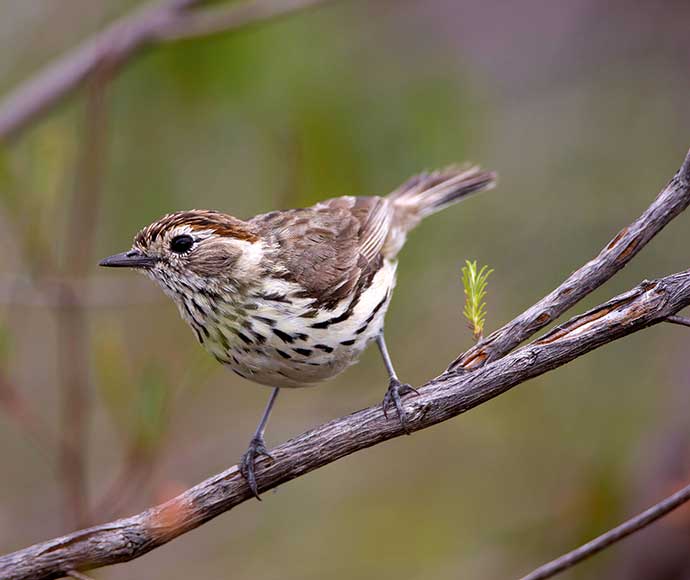Speckled warbler (Chthonicola sagittata) - vulnerable species listing
The Scientific Committee, established by the Threatened Species Conservation Act, has made a Final Determination to list the Speckled Warbler Pyrrholaemus sagittata (Latham 1802), as a VULNERABLE SPECIES on Schedule 2 of that Act. Listing of Vulnerable Species is provided for by Part 2 of the Act.
This species was formerly known as Pyrrholaemus saggitatus and Pyrrholaemus sagittata. It is now known as Chthonicola sagittata (Latham, 1801) [NSW Government Gazette No. 113, 25 November 2011, Page 6719 and NSW Government Gazette No 35, 17 March 2006, Page 1400].
NSW Scientific Committee - final determination
The Scientific Committee found that:
1. The Speckled Warbler is distributed from south-eastern Queensland, through central and eastern NSW to Victoria. In NSW, Speckled Warblers occupy eucalypt and cypress woodlands on the slopes west of the Great Dividing Range, with an extension of range into the cypress woodlands of the northern Riverina. Populations also occur in drier coastal areas such as the Cumberland Plain, Western Sydney and the Hunter and Snowy River valleys (Blakers et al. 1984, Schodde & Mason 1999).
2. Speckled Warblers inhabit woodlands with a grassy understorey, often on ridges or gullies. The species is sedentary, living in pairs or trios and nests on the ground in grass tussocks, dense litter and fallen branches. They forage on the ground and in the understorey for arthropods and seeds (Ford et al. 1986). Home ranges vary from 6-12 hectares.
3. The Speckled Warbler has declined in numbers from large parts of its range. Declines have been reported from the Cumberland Plain (Hoskin 1991; Keast 1995; Egan et al. 1997), the New England Tableland (Barrett et al. 1994), and from around Parkes (N. Schrader, unpubl.). Fisher (1997) predicted Speckled Warblers would become extinct in the Bathurst area if current land management practices were not reversed. Further, Reid (1999) identified the species as a 'decliner' in a review of bird status in the NSW sheep-wheatbelt.
4. The Speckled Warbler is threatened by clearance and fragmentation of habitat including removal of dead timber. Barrett et al. (1994) found that the species decreased in abundance as woodland area decreased, and it appears to be extinct in districts where no fragments larger than 100ha remain. Isolation of Speckled Warbler populations in small remnants increases their vulnerability to local extinction as a result of stochastic events and decreases their genetic viability in the long term. Low population densities and relatively large home range requirements also would exacerbate their vulnerability to habitat loss.
5. The preferred foraging habitat of Speckled Warbler is areas with a combination of open grassy patches, leaf litter and shrub cover. This habitat is susceptible to degradation by stock and weed invasion. Nesting on the ground also makes them vulnerable to predation from exotic mammalian predators such as foxes and cats.
6. In view of the above points, the Scientific Committee is of the opinion that the Speckled Warbler Pyrrholaemus sagittata, is likely to become endangered unless the circumstances and factors threatening its survival or evolutionary development cease to operate, and is therefore eligible for listing as a vulnerable species.
Proposed Gazettal date: 26/10/01
Exhibition period: 26/10/01 - 30/11/01
References
Barrett, G.W., Ford, H.A. and Recher, H.F. (1994). Conservation of woodland birds in a fragmented rural landscape. Pacific Conservation Biology 1, 245-256.
Blakers, M., Davies, S.J.J.F. and Reilly, P.N. (1984). 'The Atlas of Australian Birds'. Melbourne University Press: Melbourne.
Egan, K., Farrell, J. and Pepper-Edward, D. (1997). Historical and seasonal changes in the community of forest birds at Longneck Lagoon Nature Reserve, Scheyville, New South Wales. Corella 21, 1-16.
Fisher, A.M. (1997). The distribution and abundance of avifauna in the Bathurst landscape: implications for conservation and land management. Ph.D. Thesis, Charles Sturt University, Bathurst.
Ford, H.A., Noske, S. and Bridges, L. (1986). Foraging of birds in eucalypt woodlands in north-eastern New South Wales. Emu 86, 168-179.
Hoskin, E. (1991). 'Birds of Sydney 1770-1989'. Surrey Beatty and Sons: Sydney.
Keast, A. (1995). Habitat loss and species loss: the birds of Sydney 50 years ago and now. Australian Zoologist 30, 3-25.
Reid, J. (1999). 'Threatened and Declining Birds in the New South Wales Sheep-wheatbelt: Diagnosis, Characteristics and Management'. Report to NSW NPWS, Sydney.
Schodde, R. and Mason, I.J. (1999) 'The Directory of Australian Birds: Passerines'. CSIRO: Melbourne.
